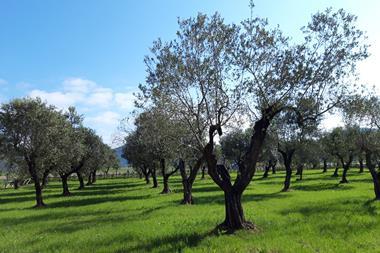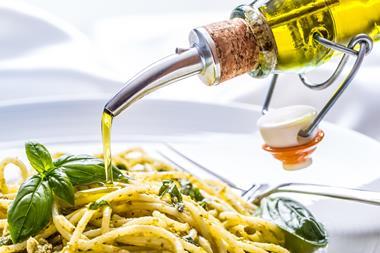
Olive oil prices increased at an “unprecedented” rate this week, after a dry September prompted speculation this year’s Spanish olive harvest could be down by half compared with last year.
At over €5,000/tonne, Spanish extra virgin olive oil hit its “highest price ever”, according to Filippo Berio MD Walter Zanre, who described the rise as a “disaster” and said the “blue touch paper has been well and truly lit” on further increases.
Earlier this month, the local government in Andalusia – a key olive-growing Spanish region – said the local harvest could be 49% smaller this year, and the second-smallest on record. In the worst-case scenario, Spain’s crop would fall to around 700,000 tonnes, the lowest since 2012-13, Zanre explained.
More optimistic forecasts were of output ending up closer to one million tonnes. But even that would be down by about 30% on last year, while harvest projections for some other olive-growing nations such as Italy and Portugal were also concerning.
“The central regions of Italy have very poor crops,” he added. “They have endured extended periods of drought and heatwaves which have compromised production.”
As a result, Zanre expected Italian extra virgin prices to top the €6,500/tonne they last reached in 2015 “before the end of the month”. This would represent more than a €500/tonne hike on the current price in just over a fortnight.
The inflation in olive oil has added €30m to Filippo Berio’s cost base, with Zanre noting the market was “still rising”.
Other big price moves since the start of October, according to data supplied by the oils giant, include a jump of €500/tonne to €5,200 for bio variants of European extra virgin olive oil.
European extra virgin prices were up €500/tonne to €4,985/tonne, while refined olive oil costs rose by €500/tonne to €4,775/tonne.
Further along the olive oil supply chain, concerns have also been raised that Italy’s millers and crushers could down tools due to soaring input costs such as fuel. However, high prices would likely, for now, persuade many to keep operating, but could see them holding back supply as they await even higher prices.
Higher yields in Greece?
According to Filippo Berio projections, Greece could make up some of the overall shortfall, with the harvest there projected to be almost 50% bigger year on year in 2022.
“At the moment it appears to be the only country in the Mediterranean with reasonable crop prospects,” Zanre said.
And yields in grower nations to the south and east could also prove positive, Filippo Berio UK projected, with Tunisia’s crop set to match last year and those of Turkey and war-wracked Syria set to increase.
“It is always difficult to estimate the overall production in both these countries, due to the very limited official and reliable data that is available,” Zanre said, referring to Turkey and Syria. “Through local agricultural contacts, we have received information indicating a good crop in both origins.”
The bigger crops projected for Greece, Syria, Turkey and Tunisia would not make up for the shortfalls elsewhere, however, putting pressure on supply and possibly forcing prices up at the retail end again this year.
Retail olive prices in the UK shot up over the summer as a skittish market reacted to drought in Italy, with week-on-week jumps of around 30% seen in some supermarket own-label variants.
And while prices have largely been held at those levels in the meantime, the latest crop projections could lead to further increases later in the year. Or the end result could be prices tailing off after consumers shun expensive olive oils.
“While some carryover from the 2021/22 crop will prevent bottlers physically running out of oil before the end of 2023, prices are still going to be very high,” Zanre warned, before asking “could this start to limit demand?”
It comes as similar demand destruction has been seen in other food sectors. Salmon prices have tumbled in recent months, according to data provided by Mintec, as inflation meant shoppers were less likely to opt for pricier fish, with knock-on impacts on demand and price.
The latest olive oil projections from Spain came a week after Ailimpo, the Spanish Lemon & Grapefruit Interbranch Organisation, said this year’s lemon crop would likely be down 10% on 2021, but Spain would retain its status as the world’s biggest exporter of the fruit.


















